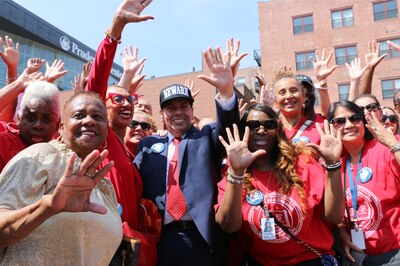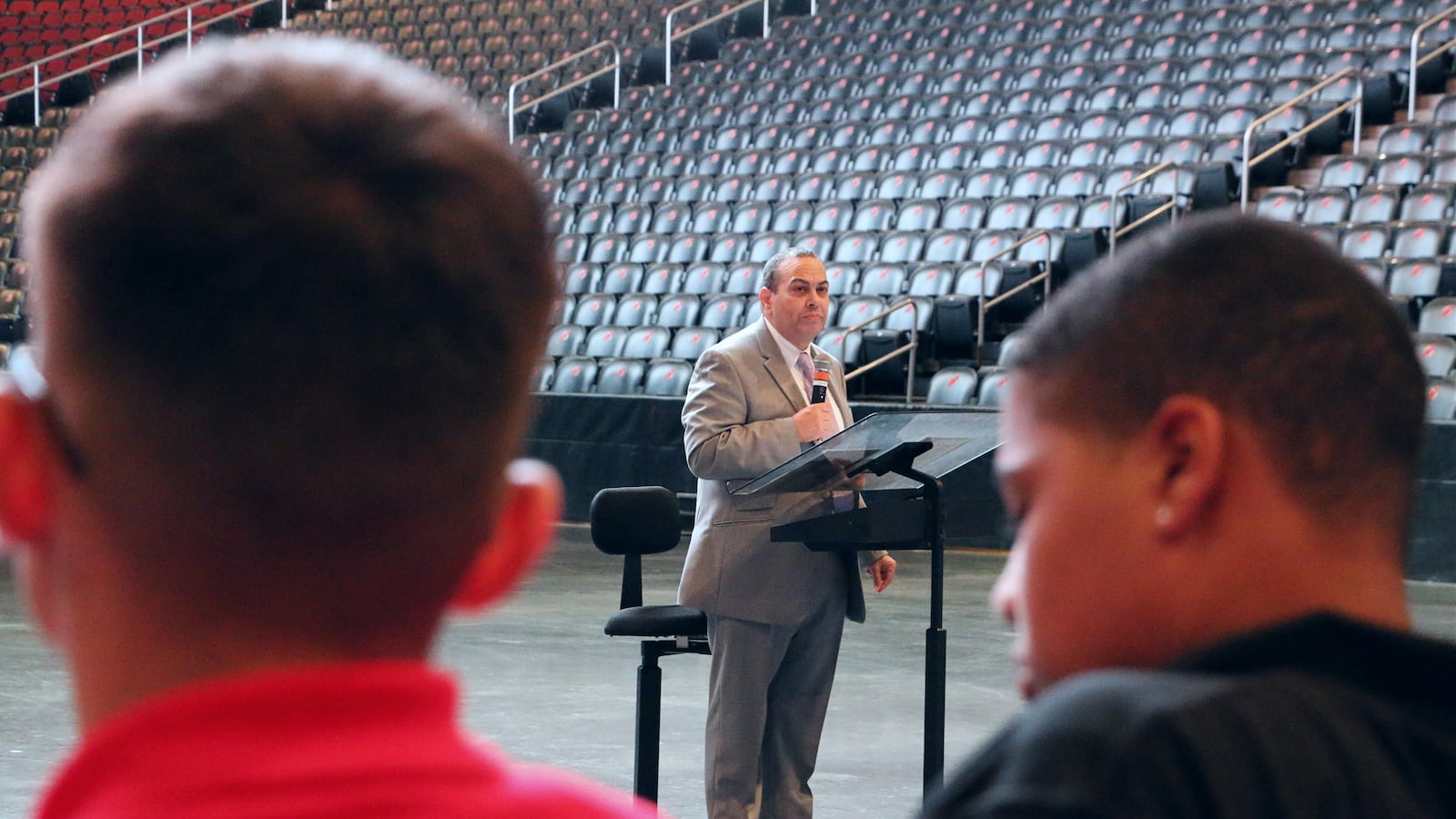As the final days of summer melted away last month and Newark families began stuffing backpacks and straightening uniforms, district officials commenced their own back-to-school tradition: They launched a new attendance campaign.
In late August, the new superintendent, Roger León, summoned the district’s entire workforce to a hockey arena to announce, among other initiatives, a plan to achieve perfect attendance in every school — an audacious and improbable goal in any district but especially so in a system where nearly one in three students is considered chronically absent. It’s part of an age-old battle — as well as a new push locally and nationally — to ensure students show up daily for class.
Before long, families were fielding calls from district employees, who had each been assigned five households to remind of the school year’s Sept. 4 start date, and from León himself, who recorded a back-to-school message. At a local principal’s request, the manager of a ShopRite supermarket even spread the word over his store’s loudspeaker.
“We want to make sure that students come to school everyday,” León told reporters after August’s all-staff meeting. “Every day matters.”
Nationwide, districts are trying to boost attendance this school year — raffling off gift cards and even cars for perfect attendance and conducting home visits — as states, including New Jersey, begin factoring absenteeism rates into school and district ratings under the Every Student Succeeds Act, the new federal education law that replaced No Child Left Behind in 2015.
In May, Gov. Phil Murphy signed new legislation requiring schools where 10 percent or more of students are chronically absent to create corrective plans. In Newark, 62 of 64 district schools had absenteeism rates that high in the 2016-17 school year, the latest for which data is publicly available.
The nationwide crackdown on absenteeism is backed by extensive research showing that students who are chronically absent — typically defined as missing 10 percent or more of the days in a single school year for any reason — are at serious risk of having lower grades and test scores, dropping out of school, and becoming ensnared in the juvenile-justice system. Low-income students, who make up three-fourths of Newark’s enrollment, are among the most likely to miss school.
But as León, a 25-year Newark Public Schools veteran who became superintendent on July 1, is sure to find, recognizing an attendance problem is one matter — solving it is quite another.
His two immediate predecessors also launched ambitious campaigns to improve attendance. But as they tried to slash through the thicket of obstacles that keep students from school — problems with health and housing, transportation and school culture — both watched their initiatives to combat absenteeism fizzle as school employees struggled to carry out the plans.
Indeed, by the end of the 2016-17 school year, the district’s chronic absenteeism rate was actually higher than in 2011-12, when the first of León’s two predecessors took the reins. Whether León will learn from their mistakes — or fall into similar traps — remains to be seen.
“The bottom line is that the superintendent can say whatever he wants,” said Pastor Van Ness Roper of True Deliverance Christian Life Church, an education advocate who was recruited to help with the first attendance campaign. “But if your staff and those you give the plan to don’t implement it, it’s just a wasted idea.”
Big ambitions, disappointing results

Five years ago, Newark’s then-state appointed superintendent, Cami Anderson, declared an absenteeism “epidemic” and insisted she had the cure.
Like León would later do, she unveiled an attendance campaign at the start of the 2013-14 school year with a lofty goal — to cut absenteeism in half within three years. If successful, the campaign, called “Attend Today, Achieve Tomorrow,” would expose students to 1 million hours of learning they would have otherwise missed, Anderson said.
Before school started, district officials asked religious leaders to adopt schools and bodegas to stop selling snacks to students during school hours. They asked community-based organizations to post back-to-school flyers and call families using scripts the district provided.
But almost immediately, the plan ran into challenges.
Three former Anderson officials said her administration struggled to stay focused on the campaign as they scrambled to enact a host of other sweeping policy changes — including a district overhaul Anderson announced in December 2013, which sparked widespread protests.
Amid that backlash, some community and parent leaders were reluctant to support Anderson’s attendance drive, even though it was relatively uncontroversial. Meanwhile, school leaders were hard pressed to meet the demands of the new campaign — which involved creating attendance plans, developing reward programs, scheduling community events, and following up with frequently absent students — without the help of attendance counselors, whom Anderson had laid off that July as a cost-cutting measure.
“There was no systemic way to deal with the attendance issue after she got rid of the attendance counselors,” said Antoinette Baskerville Richardson, a school board member at the time who is now the mayor’s education advisor. “Somebody has to be responsible who doesn’t have 100 other responsibilities.”
Officials at the time said the counselors had done little to combat absenteeism and insisted that principals and teachers needed to play a bigger role in raising attendance. But Anderson’s campaign also appeared to have a limited impact — rather than falling by 50 percent as projected, the chronic absenteeism rate was basically unchanged after three years.
Meanwhile, the firing of the 46 attendance counselors would continue to dog Anderson. In 2016, an administrative law judge sided with the Newark Teachers Union in a lawsuit challenging the layoffs, though the state education commissioner later overturned that decision. And during an earlier legislative hearing, a state lawmaker argued that the layoffs had doomed Anderson’s attendance plan from the start.
“You don’t gut out the social support network in a system like Newark,” said former Assemblywoman Sheila Oliver, now Murphy’s lieutenant governor, at the Jan. 2015 hearing, “and anticipate that we’re going to have great improvements.”
Fine-tuned policies amid daunting obstacles

Three years after the launch of Anderson’s attendance campaign, she was replaced by a new superintendent, Christopher Cerf, who in an instance of district déjà vu, newly declared absenteeism “an issue of crisis proportions” in Newark’s schools.
At an Oct. 2016 school board meeting, he said the crisis did not stem from a lack of attendance policies. For example, teachers were required to record daily attendance by 10 a.m., and schools were to call, write, and finally meet with families as absences accumulated. The problem with these plans, Cerf said, was the lack of follow-through.
“We do not believe those policies and procedures have been consistently implemented,” he said at the board meeting, “and that is on us.”
His administration set out to fix that.
Teachers were urged to take daily attendance so that schools would have reliable data to analyze. “School support teams” — the group of employees in every school who had inherited the tasks of the fired attendance counselors — were asked to review the data and come up with rewards and interventions. High schools had to establish daily “advisory” periods when faculty members would meet with a small group of students — an effort to forge personal connections strong enough to draw teenagers to school.
But a program that the district piloted during that same period, modeled off one used in New York City, suggested that schools also need more supports — not just better policy implementation — to reverse patterns of absenteeism.
At five South Ward schools that had been outfitted with extra social services through a “community schools” initiative, part-time “success mentors” were hired to work closely with students who were repeatedly absent and with their families.
Early data showed the mentors were having a positive impact on attendance — so much so that officials had hoped to place mentors in additional schools, said Brad Haggerty, Cerf’s chief innovation officer, adding that Cerf stepped down in February before the additional mentors were added. The planned expansion was a tacit acknowledgement that schools needed more people-power to curb absenteeism.
“That’s the direction we were going in — to give more people resources,” Haggerty said, adding a caveat that he believes extra personnel dedicated to attendance will only be effective if school-based teams share in the work. “You’re not going to solve that with one person.”
And some barriers to attendance go beyond policies and resources. In 2016 and 2017, the nonprofit Advocates for Children of New Jersey published reports based on interviews with students, parents, and educators that explored the tangle of factors behind Newark’s chronic absenteeism rate, which exceeds the level even in other high-poverty New Jersey districts.
Among younger students, the causes included high asthma rates and a lack of busing for students who live less than two miles from school. Among high schoolers, boring classes, long or dangerous commutes, and adult responsibilities such as caring for younger siblings or holding down jobs were cited. One student told the researchers: “I’ve gotta go out and make money. I’ll worry about school tomorrow.”
“You can’t simply mandate your way out of these kinds of issues,” said Peter Chen, who co-authored the reports with Cynthia Rice. For instance, the district can set a deadline for submitting daily attendance, he added, “But that’s not going to suddenly make students live closer to schools or their asthma go away or not have to work a job to support their family.”
A ‘refreshing’ promise to send backup

If one lesson of the past five years is the stubbornness of the district’s absenteeism problem, Newark’s new superintendent appears undaunted.
Superintendent León has set a goal of every school reaching 100 percent attendance. (Experts caution against focusing solely on attendance rates, noting that schools with high average daily attendance can still have a core group of chronically absent students.) For now, he sees his role as largely that of a cheerleader, but aims to provide more personnel in time.
“Right now, what we do is, we say, ‘The objective’s high — you figure out how to get there,’” he said in a recent interview.
He has promised to restore the attendance counselors — a move welcomed by many educators and community leaders. But, in a nod to the past, where the presence of counselors often did little to improve attendance, he insisted that schools must partner with these counselors rather than simply outsource attendance efforts to them.
“The last thing that needs to happen is for people to walk away saying, ‘Oh, attendance is going to be solved because now we have the attendance counselors,’” he said. “No, everyone has to worry about attendance.”
León pointed to his back-to-school campaign as an early success, saying this year’s first-day attendance rate was higher than last year’s. The real test, however, will be whether schools can maintain any initial gains throughout the year — when rates tend to sag — while at the same time driving down chronic absenteeism among the third of students who miss roughly a month or more of class each year.
Already, some educators say they are heartened by León’s early moves. Maria Ortiz, principal of Luis Muñoz Marin School, said the message conveyed by the back-to-school campaign and attendance counselors is that the district leadership is committed to helping schools improve attendance, rather than simply ordering them to do so.
“I don’t feel like we’re doing this alone,” she said, “which is really refreshing.”
In the coming weeks, Chalkbeat will dig deeper into Newark’s absenteeism crisis. Do you have questions you want answered? Thoughts on what causes students to miss school? Or promising attendance practices you want to highlight? If so, please take this brief survey. You can also email me at pwall@chalkbeat.org.

